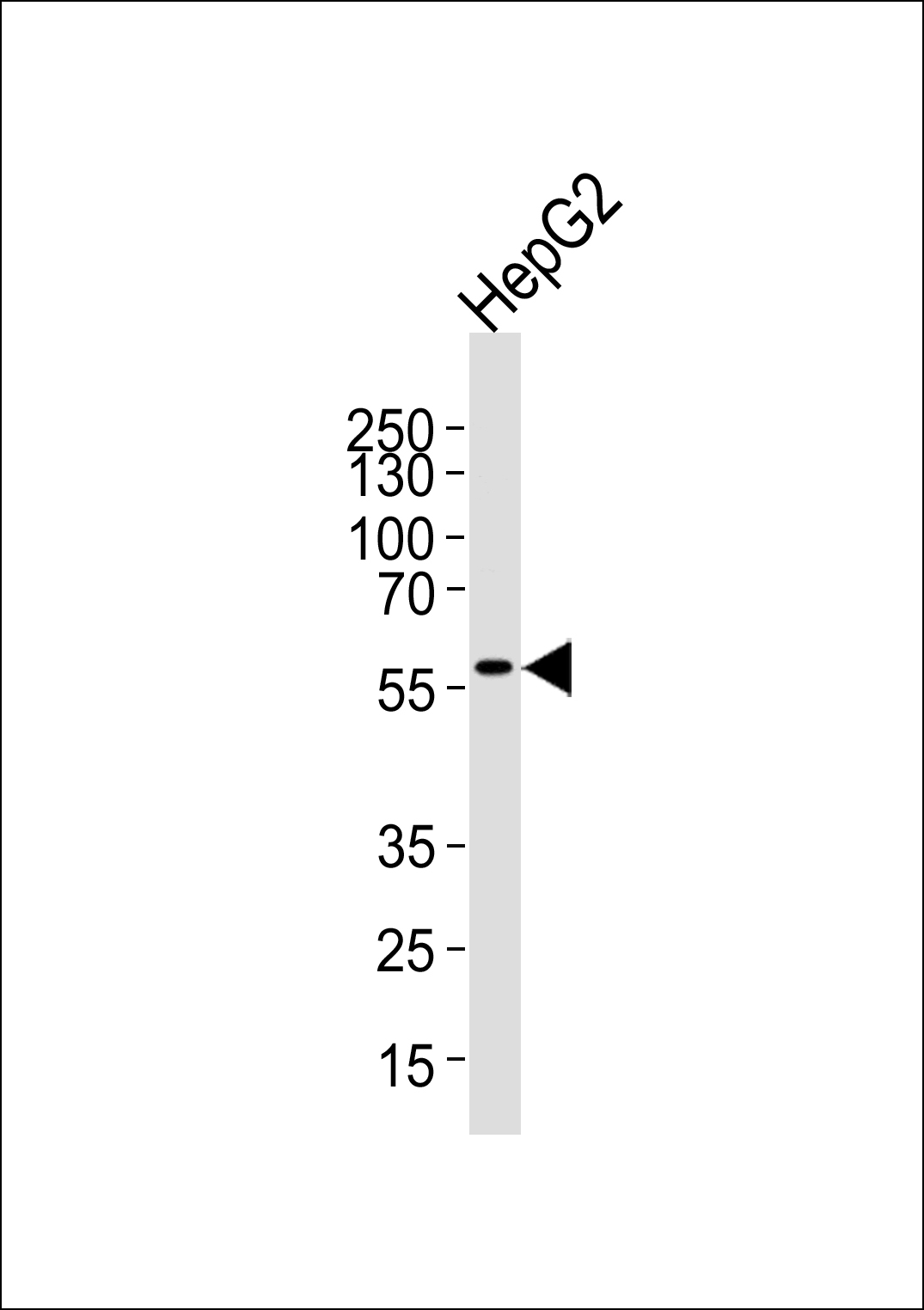AF9 (MLLT3) Antibody (Center V422)
Purified Rabbit Polyclonal Antibody (Pab)
- 产品详情
- 实验流程
- 背景知识
Application
| WB, E |
|---|---|
| Primary Accession | P42568 |
| Reactivity | Human |
| Host | Rabbit |
| Clonality | Polyclonal |
| Isotype | Rabbit IgG |
| Calculated MW | 63351 Da |
| Antigen Region | 407-438 aa |
| Gene ID | 4300 |
|---|---|
| Other Names | Protein AF-9, ALL1-fused gene from chromosome 9 protein, Myeloid/lymphoid or mixed-lineage leukemia translocated to chromosome 3 protein, YEATS domain-containing protein 3, MLLT3, AF9, YEATS3 |
| Target/Specificity | This AF9 (MLLT3) antibody is generated from rabbits immunized with a KLH conjugated synthetic peptide between 407-438 amino acids from the Central region of human AF9 (MLLT3). |
| Dilution | WB~~1:1000 E~~Use at an assay dependent concentration. |
| Format | Purified polyclonal antibody supplied in PBS with 0.09% (W/V) sodium azide. This antibody is purified through a protein A column, followed by peptide affinity purification. |
| Storage | Maintain refrigerated at 2-8°C for up to 2 weeks. For long term storage store at -20°C in small aliquots to prevent freeze-thaw cycles. |
| Precautions | AF9 (MLLT3) Antibody (Center V422) is for research use only and not for use in diagnostic or therapeutic procedures. |
| Name | MLLT3 {ECO:0000303|PubMed:16001262, ECO:0000312|HGNC:HGNC:7136} |
|---|---|
| Function | Chromatin reader component of the super elongation complex (SEC), a complex required to increase the catalytic rate of RNA polymerase II transcription by suppressing transient pausing by the polymerase at multiple sites along the DNA (PubMed:20159561, PubMed:20471948, PubMed:25417107, PubMed:27105114, PubMed:27545619). Specifically recognizes and binds acylated histone H3, with a preference for histone H3 that is crotonylated (PubMed:25417107, PubMed:27105114, PubMed:27545619, PubMed:30374167, PubMed:30385749). Crotonylation marks active promoters and enhancers and confers resistance to transcriptional repressors (PubMed:25417107, PubMed:27105114, PubMed:27545619). Recognizes and binds histone H3 crotonylated at 'Lys-9' (H3K9cr), and with slightly lower affinity histone H3 crotonylated at 'Lys-18' (H3K18cr) (PubMed:27105114). Also recognizes and binds histone H3 acetylated and butyrylated at 'Lys-9' (H3K9ac and H3K9bu, respectively), but with lower affinity than crotonylated histone H3 (PubMed:25417107, PubMed:27105114, PubMed:30385749). In the SEC complex, MLLT3 is required to recruit the complex to crotonylated histones (PubMed:27105114, PubMed:27545619). Recruitment of the SEC complex to crotonylated histones promotes recruitment of DOT1L on active chromatin to deposit histone H3 'Lys-79' methylation (H3K79me) (PubMed:25417107). Plays a key role in hematopoietic stem cell (HSC) maintenance by preserving, rather than conferring, HSC stemness (PubMed:31776511). Acts by binding to the transcription start site of active genes in HSCs and sustaining level of H3K79me2, probably by recruiting DOT1L (PubMed:31776511). |
| Cellular Location | Nucleus {ECO:0000255|PROSITE-ProRule:PRU00376, ECO:0000269|PubMed:27105114}. Chromosome. Note=Colocalizes with acylated histone H3 (PubMed:25417107, PubMed:27105114). Colocalizes with histone H3 crotonylated at 'Lys-18' (H3K18cr) (PubMed:27105114) |
| Tissue Location | Enriched in undifferentiated hematopoietic stem cells in fetal liver, cord blood and bone marrow |
For Research Use Only. Not For Use In Diagnostic Procedures.
Provided below are standard protocols that you may find useful for product applications.
BACKGROUND
The human AF9 gene is one of the most common fusion partner genes with the ALL1 gene at 11q23 (also called MLL), resulting in the t(9;11)(p22;q23). The AF9 gene is more than 100 kb, and 2 patient breakpoint cluster regions (BCRs) have been identified; BCR1 is within intron 4, previously called site A, whereas BCR2 or site B spans introns 7 and 8. Several different structural elements have been identified in AF9, including a colocalizing in vivo DNA topo II cleavage site and an in vitro DNase I hypersensitive (DNase 1 HS) site in intron 7 in BCR2. Reversibility experiments demonstrated a religation of the topo II cleavage sites. In addition, 2 scaffold associated regions (SARs) are located centromeric to the topo II and DNase I HS cleavage sites and border breakpoint regions in 2 leukemic cells lines: SAR1 is located in intron 4, whereas SAR2 encompasses parts of exons 5-7. The patient breakpoint regions of AF9 share the same structural elements as the MLL BCR. A DNA breakage and repair model for nonhomologous recombination between MLL and its partner genes, particularly AF9, has been proposed.
REFERENCES
Iida, S., et al., Oncogene 8(11):3085-3092 (1993).
Nakamura, T., et al., Proc. Natl. Acad. Sci. U.S.A. 90(10):4631-4635 (1993).
Strissel, P. L., et al., Hum. Molec. Genet. 9: 1671-1679 (2000).
终于等到您。ABCEPTA(百远生物)抗体产品。
点击下方“我要评价 ”按钮提交您的反馈信息,您的反馈和评价是我们最宝贵的财富之一,
我们将在1-3个工作日内处理您的反馈信息。
如有疑问,联系:0512-88856768 tech-china@abcepta.com.























 癌症的基本特征包括细胞增殖、血管生成、迁移、凋亡逃避机制和细胞永生等。找到癌症发生过程中这些通路的关键标记物和对应的抗体用于检测至关重要。
癌症的基本特征包括细胞增殖、血管生成、迁移、凋亡逃避机制和细胞永生等。找到癌症发生过程中这些通路的关键标记物和对应的抗体用于检测至关重要。 为您推荐一个泛素化位点预测神器——泛素化分析工具,可以为您的蛋白的泛素化位点作出预测和评分。
为您推荐一个泛素化位点预测神器——泛素化分析工具,可以为您的蛋白的泛素化位点作出预测和评分。 细胞自噬受体图形绘图工具为你的蛋白的细胞受体结合位点作出预测和评分,识别结合到自噬通路中的蛋白是非常重要的,便于让我们理解自噬在正常生理、病理过程中的作用,如发育、细胞分化、神经退化性疾病、压力条件下、感染和癌症。
细胞自噬受体图形绘图工具为你的蛋白的细胞受体结合位点作出预测和评分,识别结合到自噬通路中的蛋白是非常重要的,便于让我们理解自噬在正常生理、病理过程中的作用,如发育、细胞分化、神经退化性疾病、压力条件下、感染和癌症。






